Paper Menu >>
Journal Menu >>
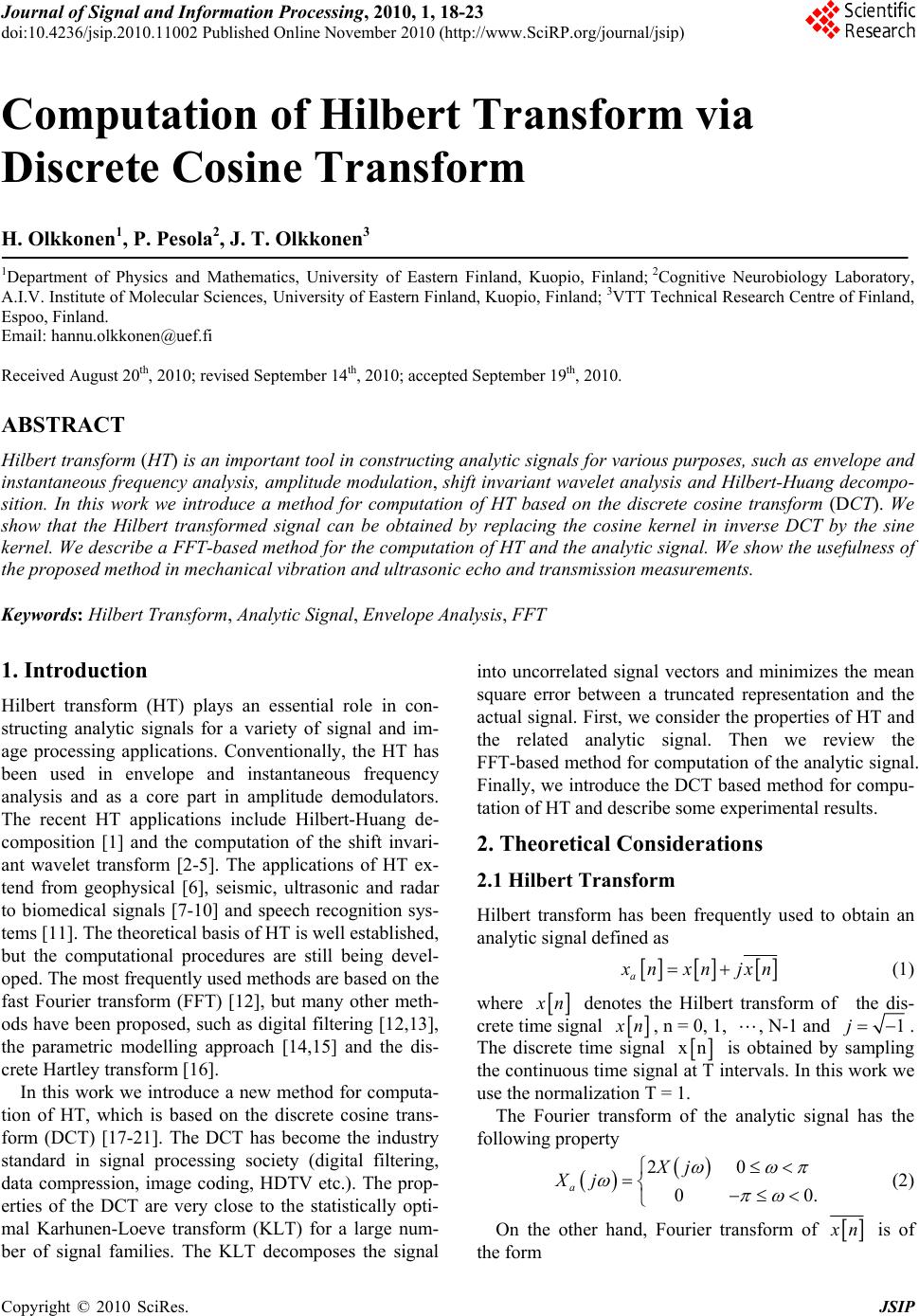 Journal of Signal and Information Processing, 20 10 , 1, 18 -23 doi:10.4236/jsip.2010.11002 Published Online November 2010 (http://www.SciRP.org/journal/jsip) Copyright © 2010 SciRes. JSIP Computation of Hilbert Transform via Discrete Cosine Transform H. Olkkonen1, P. Pesola2, J. T. Olkkonen3 1Department of Physics and Mathematics, University of Eastern Finland, Kuopio, Finland; 2Cognitive Neurobiology Laboratory, A.I.V. Institute of Molecular Sciences, University of Eastern Finland, Kuopio, Finland; 3VTT Technical Research Centre of Finland, Espoo, Finland. Email: hannu.olkkonen@uef.fi Received August 20th, 2010; revised September 14th, 2010; accepted September 19th, 2010. ABSTRACT Hilbert transform (HT) is an important tool in constructing analytic signals for various purposes, such as envelope and instantaneous frequency analysis, amplitude modulation, shift invariant wavelet analysis and Hilbert-Huang decompo- sition. In this work we introduce a method for computation of HT based on the discrete cosine transform (DCT). We show that the Hilbert transformed signal can be obtained by replacing the cosine kernel in inverse DCT by the sine kernel. We describe a FFT-based method for the computation of HT and the analytic signal. We show the usefulness of the proposed method in mech anical vibration and ultrasonic echo and transmission measuremen ts. Keywords: Hilbert Transform, Analytic Signal, Envelope Analysis, FFT 1. Introduction Hilbert transform (HT) plays an essential role in con- structing analytic signals for a variety of signal and im- age processing applications. Conventionally, the HT has been used in envelope and instantaneous frequency analysis and as a core part in amplitude demodulators. The recent HT applications include Hilbert-Huang de- composition [1] and the computation of the shift invari- ant wavelet transform [2-5]. The applications of HT ex- tend from geophysical [6], seismic, ultrasonic and radar to biomedical signals [7-10] and speech recognition sys- tems [11]. The theoretical basis of HT is well established, but the computational procedures are still being devel- oped. The most frequently used methods are based on the fast Fourier transform (FFT) [12], but many other meth- ods have been proposed, su ch as digital filtering [12,13], the parametric modelling approach [14,15] and the dis- crete Hartley transform [16]. In this work we introduce a new method for computa- tion of HT, which is based on the discrete cosine trans- form (DCT) [17-21]. The DCT has become the industry standard in signal processing society (digital filtering, data compression, image coding, HDTV etc.). The prop- erties of the DCT are very close to the statistically opti- mal Karhunen-Loeve transform (KLT) for a large num- ber of signal families. The KLT decomposes the signal into uncorrelated signal vectors and minimizes the mean square error between a truncated representation and the actual signal. First, we consider th e properties of HT and the related analytic signal. Then we review the FFT-based method for computation of the analytic signal. Finally, we introduce the DCT based method for compu- tation of HT and describe some experimental results. 2. Theoretical Considerations 2.1 Hilbert Transform Hilbert transform has been frequently used to obtain an analytic signal defined as a x nxnjxn (1) where x n denotes the Hilbert transform of the dis- crete time signal x n, n = 0, 1, , N-1 and 1j . The discrete time signal xn is obtained by sampling the continuou s time signal at T intervals. In this work we use the normalization T = 1. The Fourier transform of the analytic signal has the following property 20 00. a Xj Xj (2) On the other hand, Fourier transform of x n is of the form 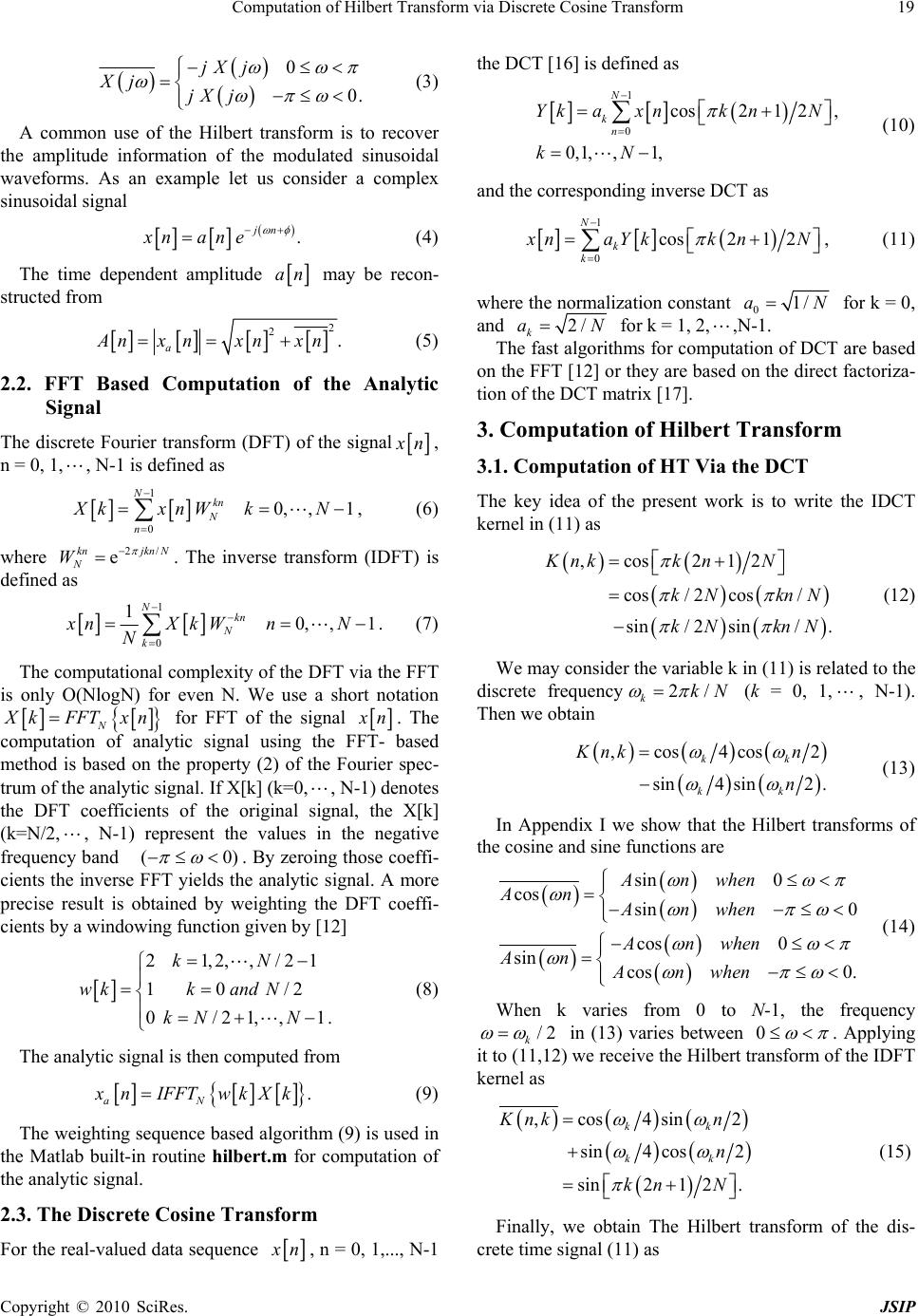 Computation of Hilbert Transform via Discrete Cosine Transform Copyright © 2010 SciRes. JSIP 19 0 0. jX j Xj jX j (3) A common use of the Hilbert transform is to recover the amplitude information of the modulated sinusoidal waveforms. As an example let us consider a complex sinusoidal sig n a l . jn xn ane (4) The time dependent amplitude an may be recon- structed from 2 2. a A nxn xnxn (5) 2.2. FFT Based Computation of the Analytic Signal The discrete Fourier transform (DFT) of the signal x n, n = 0, 1,, N-1 is defined as 1 0 0, ,1, Nkn N n XkxnW kN (6) where 2/ e knjkn N N W . The inverse transform (IDFT) is defined as 1 0 10, ,1. Nkn N k xnXkW nN N (7) The computational complexity of the DFT via the FFT is only O(NlogN) for even N. We use a short notation N X kFFTxn for FFT of the signal x n. The computation of analytic signal using the FFT- based method is based on the property (2) of the Fourier spec- trum of the analytic signal. If X[k] (k=0,, N-1) denotes the DFT coefficients of the original signal, the X[k] (k=N/2,, N-1) represent the values in the negative frequency band (0) . By zeroing those coeffi- cients the inverse FFT yields the analytic signal. A more precise result is obtained by weighting the DFT coeffi- cients by a windowing function given by [12] 21,2,,/21 10/2 0/21,,1. kN wkk andN kN N (8) The analytic signal is then computed from . aN x nIFFTwkXk (9) The weighting sequence based algorithm (9) is used in the Matlab built-in routine hilbert.m for computation of the analytic signal. 2.3. The Discrete Cosine Transform For the real-valued data sequence x n, n = 0, 1,..., N-1 the DCT [16] is defined as 1 0 cos21 2, 0,1,,1, N kn Ykaxnk nN kN (10) and the corresponding inverse DCT as 1 0cos21 2, N k k x naYk knN (11) where th e normalization constant 01/aN for k = 0, and 2/ k aN for k = 1, 2,,N-1. The fast algorithms for computation of DCT are based on the FFT [12] or they are based on the direct factoriza- tion of the DCT matrix [17]. 3. Computation of Hilbert Transform 3.1. Computation of HT Via the DCT The key idea of the present work is to write the IDCT kernel in (11) as ,cos 212 cos/ 2cos/ sin/ 2sin/. Knkk nN kN knN kN knN (12) We may consider the variable k in (11) is related to the discrete frequency2/ kkN (k = 0, 1,, N-1). Then we o bt a in ,cos4cos 2 sin4sin2. kk kk Knk n n (13) In Appendix I we show that the Hilbert transforms of the cosine and sine functions are sin 0 cos sin 0 cos 0 sin cos 0. Anwhen AnAnwhen Anwhen AnAnwhen (14) When k varies from 0 to N-1, the frequency /2 k in (13) varies between 0 . Applying it to (11,12) we receive the Hilbert transform of the IDFT kernel as ,cos4sin2 sin4 cos2 sin21 2. kk kk Knkn n kn N (15) Finally, we obtain The Hilbert transform of the dis- crete time signal (11) as 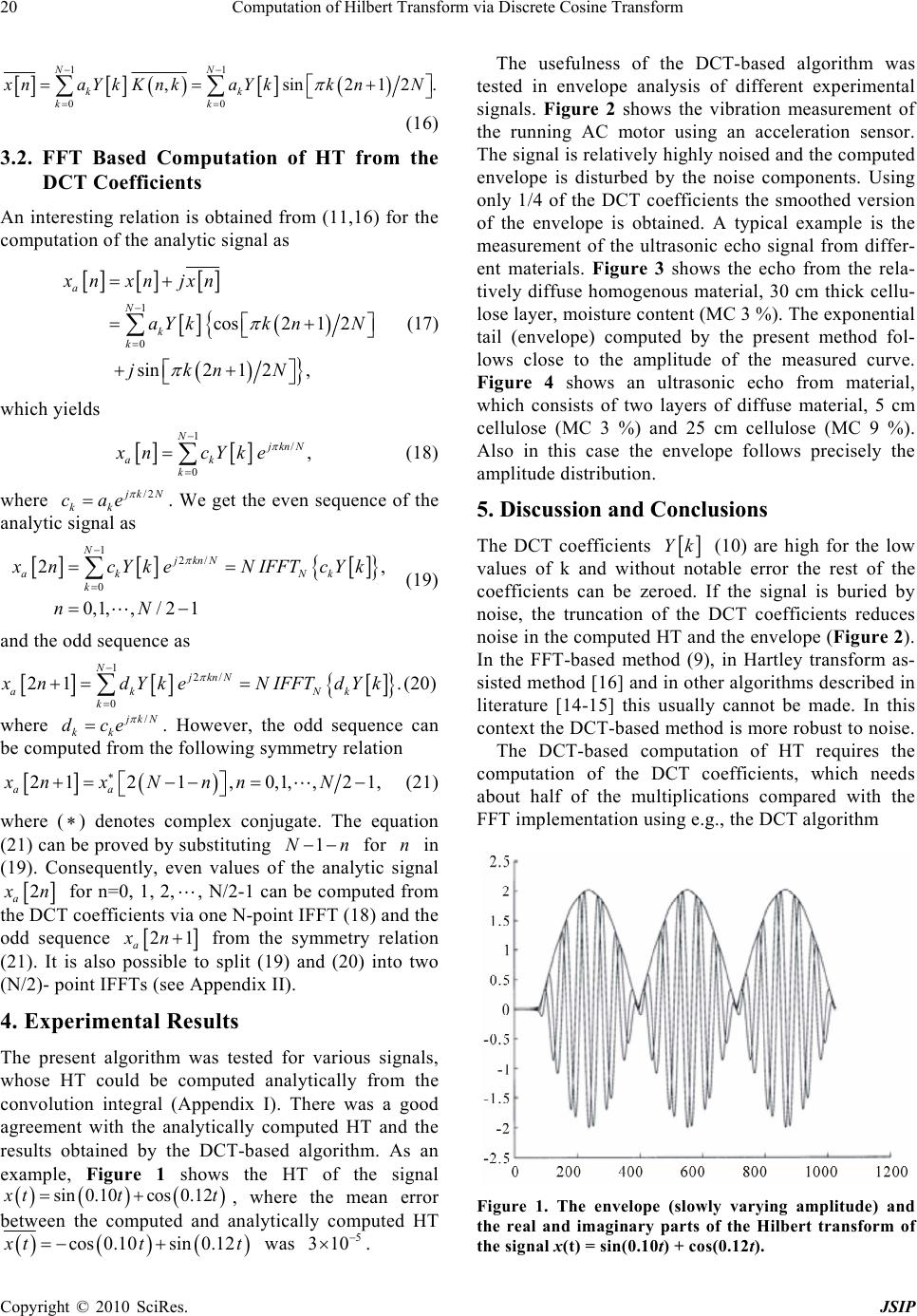 Computation of Hilbert Transform via Discrete Cosine Transform Copyright © 2010 SciRes. JSIP 20 11 00 ,sin212. NN kk kk x naYkKnkaYkk nN (16) 3.2. FFT Based Computation of HT from the DCT Co effici ent s An interesting relation is obtained from (11,16) for the computation of the analytic signal as 1 0 cos21 2 sin21 2, a N k k xn xnjxn aY kknN jknN (17) which yields 1/ 0, N j kn N ak k xn cYke (18) where /2 j kN kk cae . We get the even sequence of the analytic signal as 12/ 0 2, 0,1,,/21 NjknN ak Nk k xn cYkeNIFFTcYk nN (19) and the odd sequence as 12/ 0 21 . NjknN ak Nk k x ndYkeNIFFTdYk (20) where / j kN kk dce . However, the odd sequence can be computed from the following symmetry relation 2121, 0,1,,21, aa xnx NnnN (21) where () denotes complex conjugate. The equation (21) can be proved by substituting 1Nn for n in (19). Consequently, even values of the analytic signal 2 a x n for n=0, 1, 2,, N/2-1 can be computed from the DCT coefficients via one N-point IFFT (18) and the odd sequence 21 a xn from the symmetry relation (21). It is also possible to split (19) and (20) into two (N/2)- point IFFTs (see Appendix II). 4. Experimental Results The present algorithm was tested for various signals, whose HT could be computed analytically from the convolution integral (Appendix I). There was a good agreement with the analytically computed HT and the results obtained by the DCT-based algorithm. As an example, Figure 1 shows the HT of the signal sin 0.10cos 0.12 x ttt , where the mean error between the computed and analytically computed HT cos 0.10sin 0.12 x ttt was 5 310 . The usefulness of the DCT-based algorithm was tested in envelope analysis of different experimental signals. Figure 2 shows the vibration measurement of the running AC motor using an acceleration sensor. The signal is relatively highly noised and the computed envelope is disturbed by the noise components. Using only 1/4 of the DCT coefficients the smoothed version of the envelope is obtained. A typical example is the measurement of the ultrasonic echo signal from differ- ent materials. Figure 3 shows the echo from the rela- tively diffuse homogenous material, 30 cm thick cellu- lose layer, moisture content (MC 3 %). The exponential tail (envelope) computed by the present method fol- lows close to the amplitude of the measured curve. Figure 4 shows an ultrasonic echo from material, which consists of two layers of diffuse material, 5 cm cellulose (MC 3 %) and 25 cm cellulose (MC 9 %). Also in this case the envelope follows precisely the amplitude distribution. 5. Discussion and Conclusions The DCT coefficients Yk (10) are high for the low values of k and without notable error the rest of the coefficients can be zeroed. If the signal is buried by noise, the truncation of the DCT coefficients reduces noise in the computed HT and the envelope (Figure 2). In the FFT-based method (9), in Hartley transform as- sisted method [16] and in other algorithms described in literature [14-15] this usually cannot be made. In this context the DCT-based method is more robust to noise. The DCT-based computation of HT requires the computation of the DCT coefficients, which needs about half of the multiplications compared with the FFT implementation using e.g., the DCT algorithm Figure 1. The envelope (slowly varying amplitude) and the real and imaginary parts of the Hilbert transform of the signal x(t) = sin(0.10t) + cos(0.12t).  Computation of Hilbert Transform via Discrete Cosine Transform Copyright © 2010 SciRes. JSIP 21 based on the discrete Hartley transform [21]. The computation of the HT from the DCT coefficients given by (17-19) requires computation of one N-point IFFT. Hence, the proposed algorithm needs about 3/4 multiplications compared with the FFT-based approach (9). An alternative algorithm (Appendix II) requires two (N/2)-point IFFTs, which makes it slightly faster compared with the N-point IFFT. However, in hardware implementation the speed can be doubled by using two parallel (N/2)-point IFFT chips for com- putation of (31). The distinct difference between the proposed method and the FFT-based method is in the Fourier spectrum of the computed analytic signal. Due to window weighting given by (8,9), the negative frequency com- ponents in the FFT-based method are zero. In the Figure 2. The measurement of the vibration of the AC motor using the acceleration sensor (top). The envelope of the signal and the smoothed envelope using only 1/4 of the DCT coefficients (bottom). Figure 3. Envelope analysis of the ultrasonic echo from the homogenous material. Figure 4. Envelope analysis of the ultrasonic echo from two layers of homogenous material with different mois- ture contents. present algorithm the negative frequency components are very small (typically of the order of 4 10 ), but not precisely zero. The reason is that our approach is based on the convolution property (22) (see Appendix I), and not on the properties of the Fourier spectrum of the analytic signal (2). The usefulness of the present method was tested in connection with the ultrasonic echo measurements. The primary aim in our experiments was to develop a method for non-destructive characterization of the in- sulating materials (thickness, humidity distribution etc.). The Hilbert transformed echo signal seems highly promising in this context (Figures 3,4). In conclusion, this work proposes a new DCT-based method for computation of HT and the analytical signal. Preliminary experimental studies showed that the method is faster and more robust to noise than the FFT-based method. The present method can be easily extended to the computation of HT of 2D signals via 2D DCT algorithm. 6. Acknowledgements The authors are indebted to the reviewer’s comments, which improved the manuscript significantly. REFERENCES [1] N. E. Huang, Z. Shen, and S. R. Long, M. C. Wu, E. H. Shih, Q. Zheng, C. C. Tung, and H. H. Liu, “The Empiri- cal Mode Decomposition and the Hilbert Spectrum for Nonlinear and Nonstationary Time Series Analysis,” Proceedings of the Royal Society of London A, Vol. 454, pp. 903-995, 1998. [2] I. W. Selesnick, “Hilbert Transform Pairs of Wavelet Bases,” IEEE Signal Processing Letters, Vol. 8, No. 6, 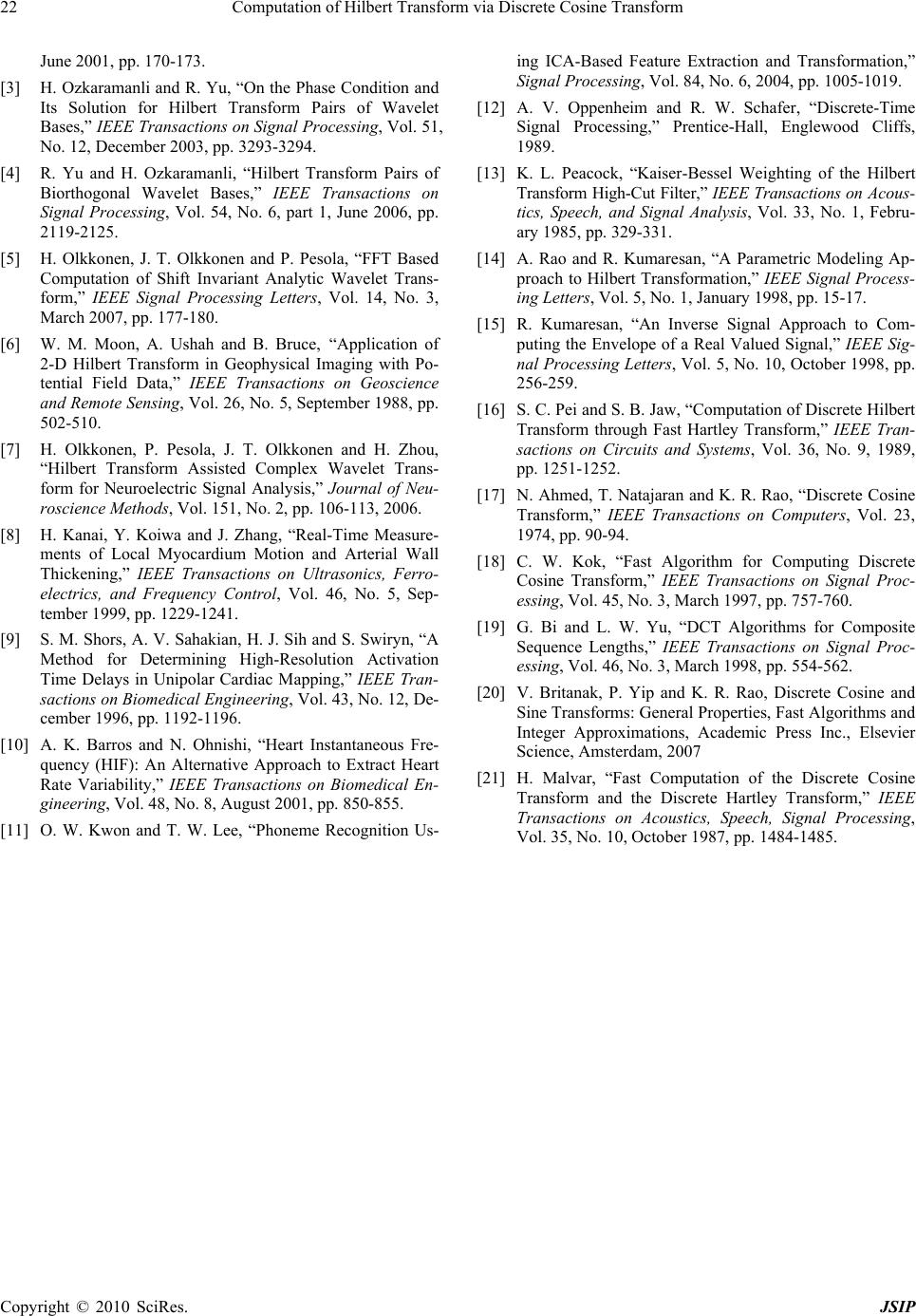 Computation of Hilbert Transform via Discrete Cosine Transform Copyright © 2010 SciRes. JSIP 22 June 2001, pp. 170-173. [3] H. Ozkaramanli and R. Yu, “On the Phase Condition and Its Solution for Hilbert Transform Pairs of Wavelet Bases,” IEEE Transactions on Signal Processing, Vol. 51, No. 12, December 2003, pp. 3293-3294. [4] R. Yu and H. Ozkaramanli, “Hilbert Transform Pairs of Biorthogonal Wavelet Bases,” IEEE Transactions on Signal Processing, Vol. 54, No. 6, part 1, June 2006, pp. 2119-2125. [5] H. Olkkonen, J. T. Olkkonen and P. Pesola, “FFT Based Computation of Shift Invariant Analytic Wavelet Trans- form,” IEEE Signal Processing Letters, Vol. 14, No. 3, March 2007, pp. 177-180. [6] W. M. Moon, A. Ushah and B. Bruce, “Application of 2-D Hilbert Transform in Geophysical Imaging with Po- tential Field Data,” IEEE Transactions on Geoscience and Remote Sensing, Vol. 26, No. 5, September 1988, pp. 502-510. [7] H. Olkkonen, P. Pesola, J. T. Olkkonen and H. Zhou, “Hilbert Transform Assisted Complex Wavelet Trans- form for Neuroelectric Signal Analysis,” Journal of Neu- roscience Methods, Vol. 151, No. 2, pp. 106-113, 2006. [8] H. Kanai, Y. Koiwa and J. Zhang, “Real-Time Measure- ments of Local Myocardium Motion and Arterial Wall Thickening,” IEEE Transactions on Ultrasonics, Ferro- electrics, and Frequency Control, Vol. 46, No. 5, Sep- tember 1999, pp. 1229-1241. [9] S. M. Shors, A. V. Sahakian, H. J. Sih and S. Swiryn, “A Method for Determining High-Resolution Activation Time Delays in Unipolar Cardiac Mapping,” IEEE Tran- sactions on Biomedical Engineering, Vol. 43, No. 12, De- cember 1996, pp. 1192-1196. [10] A. K. Barros and N. Ohnishi, “Heart Instantaneous Fre- quency (HIF): An Alternative Approach to Extract Heart Rate Variability,” IEEE Transactions on Biomedical En- gineering, Vol. 48, No. 8, August 2001, pp. 850-855. [11] O. W. Kwon and T. W. Lee, “Phoneme Recognition Us- ing ICA-Based Feature Extraction and Transformation,” Signal Processing, Vol. 84, No. 6, 2004, pp. 1005-1019. [12] A. V. Oppenheim and R. W. Schafer, “Discrete-Time Signal Processing,” Prentice-Hall, Englewood Cliffs, 1989. [13] K. L. Peacock, “Kaiser-Bessel Weighting of the Hilbert Transform High-Cut Filter,” IEEE Transactions on Aco us- tics, Speech, and Signal Analysis, Vol. 33, No. 1, Febru- ary 1985, pp. 329-331. [14] A. Rao and R. Kumaresan, “A Parametric Modeling Ap- proach to Hilbert Transformation,” IEEE Signal Process- ing Letters, Vol. 5, No. 1, January 1998, pp. 15-17. [15] R. Kumaresan, “An Inverse Signal Approach to Com- puting the Envelope of a Real Valued Signal,” IEEE Sig- nal Processing Letters, Vol. 5, No. 10, October 1998, pp. 256-259. [16] S. C. Pei and S. B. Jaw, “Computation of Discrete Hilbert Transform through Fast Hartley Transform,” IEEE Tran- sactions on Circuits and Systems, Vol. 36, No. 9, 1989, pp. 1251-1252. [17] N. Ahmed, T. Natajaran and K. R. Rao, “Discrete Cosine Transform,” IEEE Transactions on Computers, Vol. 23, 1974, pp. 90-94. [18] C. W. Kok, “Fast Algorithm for Computing Discrete Cosine Transform,” IEEE Transactions on Signal Proc- essing, Vol. 45, No. 3, March 1997, pp. 757-760. [19] G. Bi and L. W. Yu, “DCT Algorithms for Composite Sequence Lengths,” IEEE Transactions on Signal Proc- essing, Vol. 46, No. 3, March 1998, pp. 554-562. [20] V. Britanak, P. Yip and K. R. Rao, Discrete Cosine and Sine Transforms: General Properties, Fast Algorithms and Integer Approximations, Academic Press Inc., Elsevier Science, Amsterdam, 2007 [21] H. Malvar, “Fast Computation of the Discrete Cosine Transform and the Discrete Hartley Transform,” IEEE Transactions on Acoustics, Speech, Signal Processing, Vol. 35, No. 10, October 1987, pp. 1484-1485. 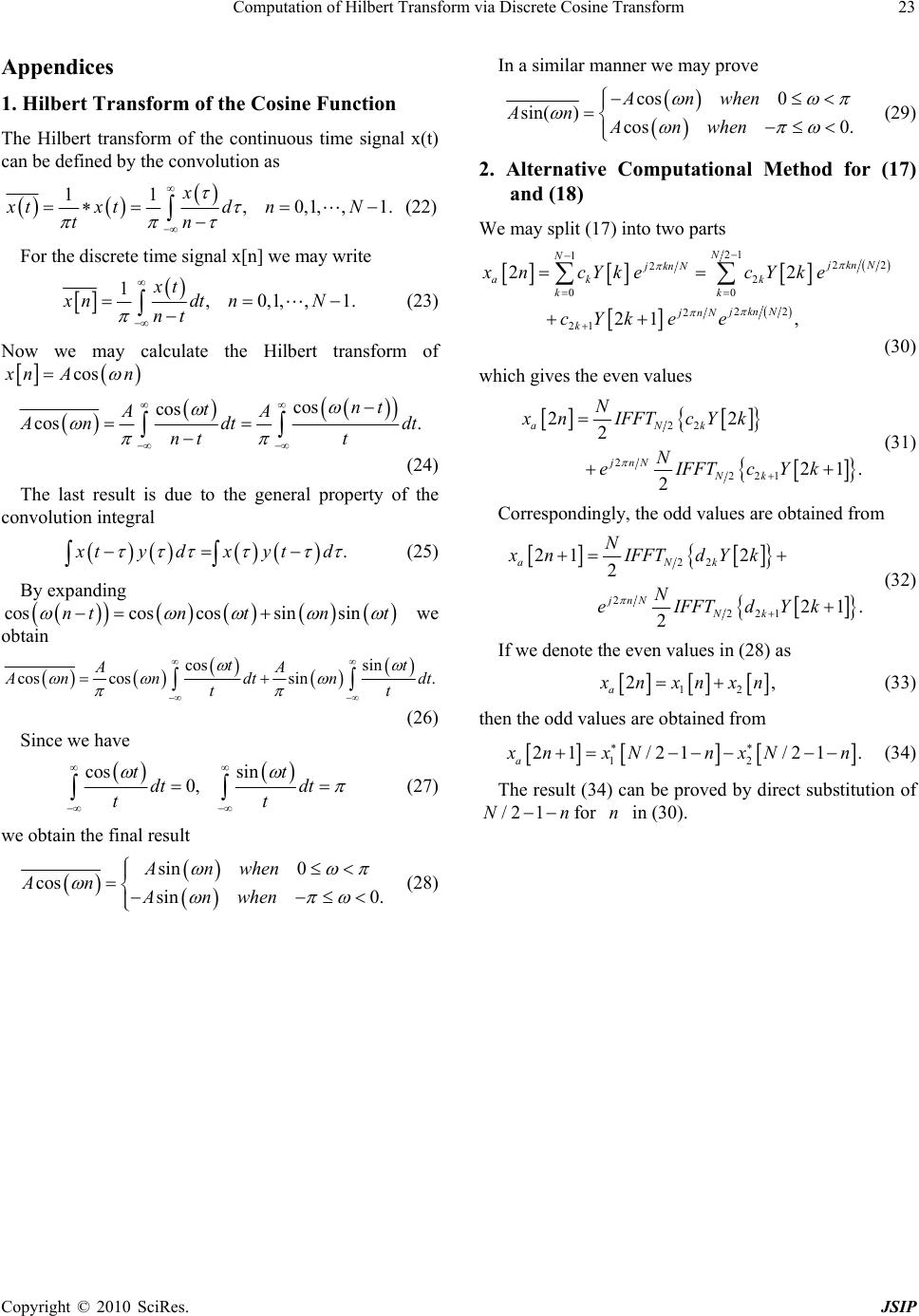 Computation of Hilbert Transform via Discrete Cosine Transform Copyright © 2010 SciRes. JSIP 23 Appendices 1. Hilbert Transform of the Cosine Function The Hilbert transform of the continuous time signal x(t) can be defined b y the convolution as 11 ,0,1,,1. x xtxtd nN tn (22) For the discrete time signal x[n] we may write 1,0,1,,1. xt xndtnN nt (23) Now we may calculate the Hilbert transform of cos x nA n cos cos cos . nt t AA A ndtdt nt t (24) The last result is due to the general property of the convolution integral . x tydxytd (25) By expanding coscos cossin sinntntnt we obtain cos sin cos cossin. tt AA A nndtndt tt (26) Since we have cos sin 0, tt dt dt tt (27) we obtain the final result sin 0 cos sin 0. Anwhen AnAnwhen (28) In a similar manner we may prove cos 0 sin( )cos 0. Anwhen An Anwhen (29) 2. Alternative Computational Method for (17) and (18) We may split (17) into two parts 21 122 22 00 22 2 21 22 21 , N NjknN jknN ak k kk jknN jnN k xn cYkecYke cYk ee (30) which gives the even values 22 2221 22 2 21. 2 aNk jnN Nk N xnIFFTcYk N eIFFTcYk (31) Correspondingly, the odd values are obtained from 22 2221 21 2 2 21. 2 aNk jnN Nk N xnIFFTd Yk N eIFFTdYk (32) If we denote the even values in (28) as 12 2, a x nxnxn (33) then the odd values are obtained from 12 21/21/21 . a x nxN nxN n (34) The result (34) can be proved by direct substitution of /2 1Nn for n in (30). |

